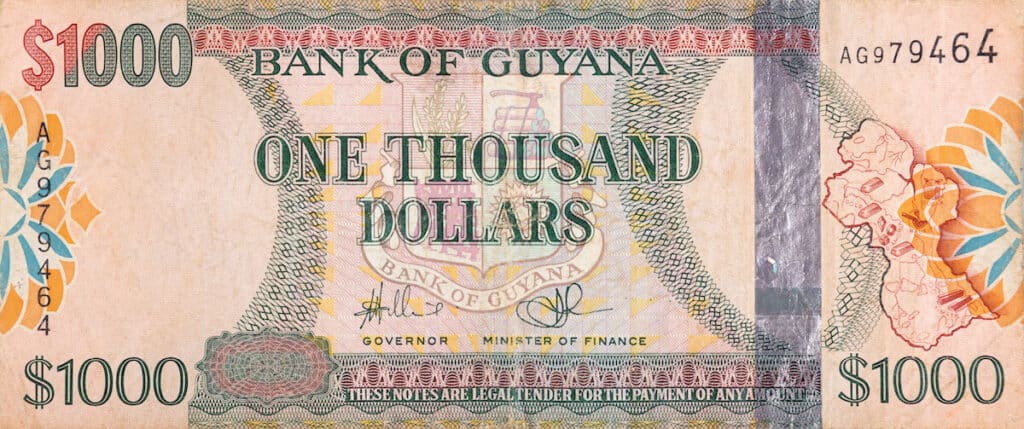Known for its abundance of natural resources, including recently discovered oil fields, Guyana is a country in South America with an interesting economic history. From its colonial past to independent oil wealth, there’s a lot to learn about the Guyana economy and how the official Guyana currency, the Guyanese dollar (G$), came to be.
What is the Guyana currency?
The Guyanese dollar, denoted by G$ and GYD, has been the official currency of Guyana since the 1800s. The central bank, called the Bank of Guyana, manages the financial policy and issues banknotes and coins in the country.
Unlike the Senegal currency (the West African CFA franc), the Guyanese dollar does not have a fixed exchange rate.
The history of Guyana and its currency

Like many economies in the world, Guyana’s evolved over time. Various currencies were in use during their colonial periods, and since the Guyana dollar began circulating, it’s undergone several changes.
Here’s a brief overview of how the banknotes and coins evolved over the years as the country changed and how the official currency is used today.
Prior to the 16th century, Guyana was inhabited by indigenous people who called it “guiana,” which literally translated to the “land of water.” In the late 16th century, the Dutch colonized Guyana, and eventually, Dutch coins, such as the Guilder, started being used.
Other currencies also made their way to Guyana as French, Spanish, and British colonists arrived.
In 1831, Guyana became an official colony of Britain. During the British colonial period, the region now known as Guyana was called “British Guiana” and was considered part of the British West Indies (BWI). The BWI included the following British territories:
- Anguilla
- The Cayman Islands
- Turks and Caicos Islands
- Montserrat
- The British Virgin Islands
- Antigua and Barbuda
- The Bahamas
- Barbados
- Dominica
- Grenada
- Jamaica
- Saint Kitts and Nevis
- Saint Lucia
- Saint Vincent and the Grenadines
- British Guiana (now Guyana)
- Trinidad and Tobago
- Bermuda
- British Honduras (now Belize)
During this period, British coins, such as the 2-pence and 4-pence, circulated in the British West Indies territories, but Dutch coins also continued to circulate until 1900. Interestingly, even after Britain stopped using the 4-pence coin, it continued to be produced exclusively for use in British Guiana.
In 1916, Britain introduced paper money in denominations of 1 and 2 dollars. By 1937, they also introduced banknotes with denominations of 5, 10, 20, and 100 dollars.
In 1966, Guyana gained independence and started circulating new coins and banknotes. These included coins with denominations of 1, 5, 10, 25 and 50 cents, which stopped circulating over the years. New coins with denominations of 1, 5 and 10 dollars replaced the older coins.
Today, the central bank issues the Guyana currency in the following denominations:
- Banknotes: $20, $50, $100, $500, $1,000, and 5,000
- Coins: $1, $5, $10, and $100
Guyana also uses banknotes that include features to help blind and visually impaired people recognize the denominations of the banknotes through touch.
As for the administration, Guyana went through several changes after the nation’s independence and today, Guyana works as a parliamentary representative democratic republic. It is now divided into 10 administrative regions:
- Barima Waini
- Pomeroon-Supenaam
- Essequibo Islands-West Demerara
- Demerara- Mahaica
- Mahaica-Berbice
- East Berbice-Corentyne
- Cuyuni-Mazaruni
- Potaro-Siparuni
- Upper Takutu-Upper Essequibo
- Upper Demerara-Upper Berbice
These regions are administered by the Regional Democratic Council (RDC). The regions are further divided into neighborhood councils and are run by the Neighbourhood Democratic Councils (NDCs).
The current culture in Guyana is similar to that of the English-speaking Caribbean regions. It is the only English-speaking country in South America and people in the region speak Guyanese Creole, which can be described as an English-based Creole.
Other languages commonly used include Hindi, Amerindian languages, Spanish, and Portuguese.
5 facts to know about Guyana’s currency and economy

1. Only the Bank of Guyana can issue banknotes and coins.
Today only the central bank, the Bank of Guyana, has the authority to manage the official currency of Guyana and issue banknotes and coins in the legal tender to keep the money circulating.
Today, the central bank also manages pensions and other finance departments.
2. The Guyana currency is cash-focused.
People in Guyana typically use cash for transactions so it helps to have banknotes and coins handy. Credit cards are rarely used and only accepted in tourist regions, so if you plan to visit the smaller towns, swap your credit card for local cash.
3. The new $1,000 banknote has security features.
In 2019, owing to an influx of counterfeited banknotes, the Bank of Guyana decided to introduce a new $1,000 banknote with added security features.
The new security features include Crane Currency’s RAPID micro-optic security thread. Users can tilt the banknote to check if they notice movement, which is an indication that the $1,000 banknote is genuine.
Despite the new developments, the previously issued banknotes are still considered legal tender.
4. The discovery of oil fields boosted Guyana’s economy.
In 2015, Exxon Mobil Corp., an oil and gas company, discovered oil in Guyana. Over the next five years, 17 more oil fields were discovered, and now the number has reached 30. This boosted Guyana’s GDP and the International Monetary Fund predicted, “Guyana’s economic growth could reach close to 60% this year.”
In fact, Guyana was one of the few economies experiencing GDP growth in 2020 when other economies were slowing down or coming to a standstill due to the pandemic.
5. Agriculture sustains the Guyana economy.
Agricultural and related industries are the biggest contributors to Guyana’s GDP. Nearly 30% of the country’s working population works in agriculture, keeping the Guyana currency pumping into the local economy.
Some of the products grown and harvested include sugar, rice, plantains, and herbs like cilantro. The country is also able to produce organic food—like cocoa, pineapple, and heart of palm—thanks to having agricultural land that’s free of chemicals.
Adjacent industries, like seafood and fisheries, also thrive in Guyana, owing to the country’s vast coastline.
Understanding Guyanese currency exchange rates

If you’re sending money to or from Guyana, it’s important to know how the foreign exchange works and what kind of exchange rate you would have to pay.
Guyana’s currency—the Guyanese Dollar (GYD)—does not have a fixed exchange rate. It is not pegged to the U.S. dollar (USD), British pound sterling (GBP), or the euro (EUR), so the foreign exchange conversion rate may vary.
Using the currency converter on our website or in our app can help you quickly estimate the exchange rate.
Sending money to Guyana
Any time you need to send money to Guyana, Remitly can help. Remitly makes international money transfers faster, easier, more transparent, and more affordable. Our reliable and easy-to-use mobile app is trusted by over 5 million people around the world.
Download the app today to give it a try!
